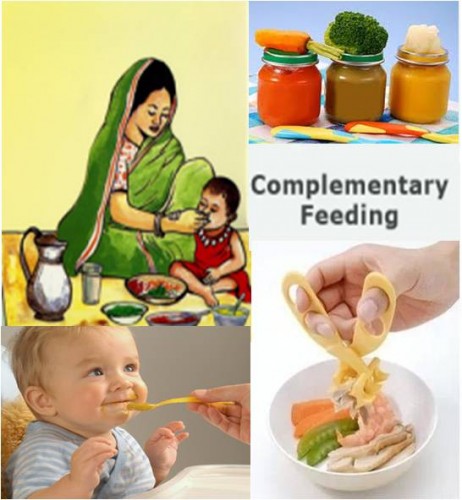
Para sa mga Mommy at Daddy, ito ang ilang mga tips at impormasyon para sa tamang pagpapakain kay baby.
Mga dapat tandaan:
Exclusive breastfeeding – ito ay ang eksklusibong pagbibigay ng gatas ng ina na nagtataglay ng sapat at naaayon na sustansya sa sanggol sa loob ng anim na buwan.
Complimentary feeding – ay ang pagbibigay ng ibang mga pagkain at likido sa mga sanggol simula sa kanyang ika-anim na kumpletong buwan habang ipinagpapatuloy ang breastfeeding.
Beikost – ang tawag sa solid food o iba pang pagkain maliban sa gatas.
Food Allergy – ay sanhi ng mga food allergens na karaniwang natatagpuan sa pagkaing mayaman sa protina tulad ng mani, itlog, gatas at manok.
Mga Tips sa Pag-uumpisa ng Pagpapakain kay Baby:
1. Magsimula ng complementary feeding sa edad na anim na buwan. Maaaring magbigay ng lugaw na malapot,2 beses sa isang araw, 2 hanggang 3 kutsara sa bawat kainan.
2. Maaaring magbigay ng mga pagkain na minasa (mashed), hinimay, tinanggalan ng mga buto o tinik at tinadtad. Iwasan din ang paggamit ng mga artipisyal na pampalasa sa pagkain ng bata.
3. Dagdagan ang dami ng pagkain habang lumalaki ang bata kasabay ng patuloy at madalas na pagpapasuso. Dalasan din ang pagpapakain habang lumalaki ang bata.
4. Unti-unting palaputin at iba-ibahin ang pagkain habang lumalaki ang bata. Ibigay ang diyeta sa pangangailangan at kakayahan ng sanggol. Ibigay ang iba’t-ibang uri ng pagkain tulad ng GO, GROW at GLOW foods.
5. Lugaw, prutas, isda at iba pang malalambot na karne, mga buto, gulay, pula ng itlog, gelatin at buong itlog. Ito ang tamang pagkakasunud-sunod kung pano ibibigay kay baby ang mga nabanggit na pagkain.
6. Iwasang ibigay agad kay baby ang mga pagkaing maaaring magdulot ng allergy tulad ng manok, puti ng itlog, kamatis, mga maaasim na prutas, chocolate, gatas ng baka at mga lamang-dagat.
7. Iwasang pilitin ang bata na kumain at wag magpakita ng disgust sa pagkain na iyong ipinapakain tulad ng di pagkain ng gulay.
Paano malalamang tama at sapat ang pinapakain kay baby?
1. Patuloy ang pagbigat at pagtangkad ni baby
2. Magana ang pagkain
3. Masayahin at aktibo
4. Mahimbing matulog
5. May normal na pagdumi
6. Malakas ang pangangatawan at maganda ang kutis.
Tandaan na ang tamang nutrisyon para kay baby ay malaking factor sa kanyang paglaki.
Proper nutrition among infants is a very important factor in achieving normal growth and development. Breast milk may provide several nutrients, but it may not be sufficient to sustain the child's nutritional needs. Hence, the introduction of solid and other kinds of foods is also necessary. To help you begin, here are some tips to guide you about the proper way of complementary feeding:
1. Start complementary feeding at the age of 4 months (earliest) to 6 months because in this stage, the baby's digestive system can now handle other food aside from breast milk or formula milk and can now practice his ability to chew and swallow solid foods. Also, at this stage, the baby's demands for nutrients increases in order to sustain physical growth.
2. Learn how to recognize that your baby is ready to try solid foods. These include good head control and able to sit up with support, watching and leaning forwards when food is around, reaching out to grab food or spoons to put in their mouth and opening their mouth when food is offered.
3. When you start complementary feeding, introduce one food at a time. Wait two or three days before you begin giving another kind of food. Through this, you will be able to determine your baby's food allergies by simply observing his reaction to the intake of food. Diarrhea, vomiting and appearance of rash are some of the indicators.
4. Do not stop giving the food when the baby refuses to eat it. It takes a while before they accept a new food.
5. Cereal is not the only available option to start with. You can begin introducing meat too, such as pureed chicken. Research shows that babies who eat meat earlier have a higher intake of zinc and iron, nutrients important for growth.
7. Who says that babies want bland foods? You can spice things up using mild herbs. There are endless possibilities that you can make with your puree. You may try to blend cilantro into avocado, nutmeg into sweet potatoes or cinnamon into apples.
8. Make feeding time also a learning time. Help your baby connect with the food. For example, when you hand him a certain fruit, tell him the name of the fruit. Through this, the baby may have an early recognition of the things around him.
Not all babies may show the same response as you introduce solid foods. Hence, you must learn how to assess his readiness and be able to individualize your feeding plan.